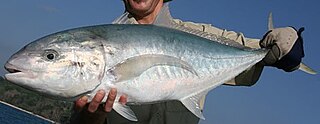
The bludger, also known as the bludger trevally, nakedbreast trevally or Bleeker's jackfish, is a widespread species of large marine fish in the jack family, Carangidae. The bludger inhabits the tropical and subtropical regions of the Indo-west Pacific Ocean, distributed from South Africa in the west to Japan and New Caledonia in the east. It is a large fish, growing to a maximum recorded length of 90 cm, and is very similar to the yellowspotted trevally, Carangoides fulvoguttatus, but can be separated by the complete absence of breast scales and a number of other anatomical features. The species inhabits moderately deep offshore coral and rocky reefs, where it preys on small crustaceans and fish. The reproductive biology of the species is poorly known, but it appears to move to more tropical waters to spawn. The bludger is of intermediate importance to fisheries throughout its range, taken by hook and line and various netting methods. It is of some value to anglers also, considered a good gamefish, but generally regarded as poor eating due to its soft oily flesh, which is used as bait by many anglers. The name ‘bludger’ is said to either refer to the blunt head of the species, or the destination of the fish when caught by professional fishermen who treat the fish as discard.

The Malabar trevally, also known as the Malabar jack, Malabar kingfish or nakedshield kingfish, is a species of large inshore marine fish of the jack family, Carangidae. It is distributed throughout the Indian and west Pacific Oceans from South Africa in the west to Japan and Australia in the east, inhabiting reefs and sandy bays on the continental shelf. The Malabar trevally is similar to many of the other species in the genus Carangoides, with the number of gill rakers and the grey-brown colour of the tongue being the diagnostic features. The Malabar trevally is a predator, taking a variety of small fish, cephalopods and crustaceans. The species is of minor economic importance throughout its range, caught by a variety of net and handline methods.

The cleftbelly trevally, also known as the cleftbelly kingfish, Kuweh trevally or thin crevalle, is a species of tropical marine fish of the jack family, Carangidae. The species inhabits coastal waters throughout the Indo-West Pacific region from South Africa in the west to Japan in the east, often found near the water's surface. The cleftbelly trevally is the only member of the genus Atropus and is distinguished by a number of anatomical characteristics, with a deep median groove in the belly giving the species its common name. It is not a large fish, growing to a maximum recorded length of 26.5 cm. Cleftbelly trevally are predatory fish, taking a variety of small crustaceans and fish. The species is of minor importance to fisheries throughout its range.
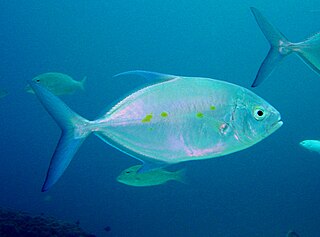
Carangoides is a genus of tropical to subtropical marine fishes in the jack family, Carangidae. They are small- to large-sized, deep-bodied fish characterised by a certain gill raker and jaw morphology, often appearing very similar to jacks in the genus Caranx. They inhabit the subtropical and tropical regions of the Indian, Pacific, and Atlantic Oceans, often occupying coastal areas, including reefs, bays, and estuaries, rarely venturing far offshore. They are all predatory fishes, taking a variety of smaller fishes, crustaceans and cephalopods as prey. The genus was first erected in 1851 by Pieter Bleeker for an unknown taxon and currently contains 20 species. Many make up significant proportions of various fisheries, although a number of ciguatera cases have been attributed to them.
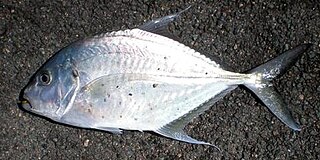
The longnose trevally, also known as the tea-leaf trevally, club-nosed trevally, grunting trevally or dusky trevally, is a species of inshore marine fish in the jack family, Carangidae. The species is distributed throughout the tropical and subtropical waters of the Indian and west Pacific Oceans from South Africa to New Zealand and Japan, inhabiting coastal waters, especially reefs, to a depth of 90 m. The longnose trevally is distinguished from similar species by a combination of a scaleless breast and the number of gill rakers and fin rays. It is a moderately large fish, growing to a maximum known length of 72 cm and 4.35 kg. The longnose trevally is a predatory fish, consuming small fish, crustaceans and molluscs. The species is of minor commercial importance throughout its range, and is considered to be a good table fish.
Carangoides ciliarius is a dubious species of marine fish in the jack and horse mackerel family, Carangidae. The validity of the species has been questioned by a number of authors, with many concluding it is a synonym of the similar Carangoides armatus, commonly known as the longfin trevally. However, this synonymy has not been accepted by all authorities, with Fishbase and ITIS both recognising it as a valid species. Like Carangoides armatus, the species is occasionally referred to as the 'longfin kingfish'.

The coastal trevally, also known as the onion trevally, Japanese trevally or bluefin kingfish, is a species of inshore marine fish in the jack family Carangidae. The species is distributed throughout the tropical and subtropical waters of the Indian and west Pacific Oceans, from South Africa in the west to Japan and New Caledonia in the east, reaching as far south as Australia. The species is found on deep coastal reefs, both in schools and as solitary individuals, where they prey on small midwater organisms including crustaceans, small fish and cephalopods. The species is taken as bycatch in a number of fisheries throughout its range by a number of fishing methods and is of little commercial value, but is considered to be a good table fish. A mistype in the original volume in which Eduard Rüppell named the species led to the combination Carangoides caeruleopinnatus, which has incorrectly spread through the literature.

The shadow trevally, also known as the shadow kingfish, twothread trevally or Aldabra trevally, is a species of inshore marine fish in the jack family Carangidae. The species is patchily distributed throughout the tropical and subtropical waters of the Indian and west Pacific Oceans, from South Africa in the west to Japan and Samoa in the east, reaching as far south as Indonesia and New Caledonia. It is most easily distinguished from similar species by as series of dark rectangular blotches under the second dorsal fin, giving a 'shadowed' appearance, from which its common name is derived. The shadow trevally is a reasonably large fish, growing to 85 cm in length and at least 2.6 kg in weight. It inhabits shallow coastal waters, including reefs, bays, and estuaries, where it takes small fish and benthic crustaceans as prey. Nothing is known of the species' ecology and reproductive biology. It is of little importance to fisheries, and is occasionally taken by bottom trawls and other artisanal fishing gear.

The threadfin jack or thread pompano is a species of coastal marine fish in the jack family Carangidae. The species inhabits the tropical waters of the eastern Pacific Ocean from Baja California in the north to Ecuador and the Galapagos Islands in the south. It is a moderately large fish, growing to 60 cm (24 in) and may be recognized by its filamentous dorsal and anal fin lobes. The threadfin jack inhabits both deeper coastal waters and inshore environments, including reefs and estuaries, where it preys on minute benthic and pelagic organisms, including small fishes and crustaceans. Very little is known about the ecology and reproductive cycle in the species. The threadfin jack is of importance to fisheries throughout its distribution, caught by hook-and-line and net methods and marketed fresh and salted, and is considered a very good table fish. The species was named Carangoides dorsalis by Theodore Gill 20 years before the name Caranx otrynter was introduced, but confusion with Vomer dorsalis led to the proposal of the new name to separate the two species.

Caranx is a genus of tropical to subtropical marine fishes in the jack family Carangidae, commonly known as jacks, trevallies and kingfishes. They are moderate- to large-sized, deep-bodied fishes which are distinguished from other carangid genera by specific gill raker, fin ray and dentition characteristics. The genus is represented in the Pacific, Indian and Atlantic Oceans, inhabiting both inshore and offshore regions, ranging from estuaries and bays to deep reefs and offshore islands. All species are powerful predators, taking a variety of fish, crustaceans and cephalopods, while they in turn are prey to larger pelagic fishes and sharks. A number of fish in the genus have a reputation as powerful gamefish and are highly sought by anglers. They often make up high amounts of the catch in various fisheries, but are generally considered poor to fair table fishes.
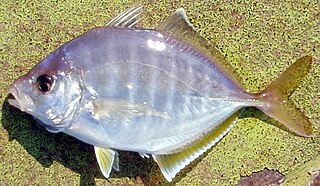
The whitefin trevally, also known as the horse trevally, is a species of deep water offshore fish in the jack family Carangidae. The species inhabits the tropical to temperate waters of the Indo-Pacific and central Pacific, ranging from South Africa in the west to Hawaii in the east. The whitefin trevally is a moderate-sized fish, growing to 37 cm, and is distinguished by a number of morphological traits, including fin size, gill raker count, and colour. It inhabits the continental shelf and slope at depths to 200 m over sand and mud substrates, where it preys on fish, crustaceans, and cephalopods. Studies in Japan indicate a length at sexual maturity of 17.4 cm on average, with spawning occurring between May and October, with each individual spawning multiple times. Whitefin trevallies are of high importance to fisheries in Japan, where they are taken by trawlers, although the catch numbers have halved since the 1980s. It is of minor importance elsewhere throughout its range, but is considered a good table fish.

The yellowspotted trevally, also known as the yellowspotted kingfish, goldspotted trevally, tarrum, or yellowspot, is a widespread species of large inshore marine fish in the jack family Carangidae. The yellowspotted trevally inhabits the tropical and subtropical waters of the western Indo-Pacific region, from South Africa in the west to Japan and Australia in the east. The species is known to grow to a maximum length of at least 1.2 m, and is distinguished by gill raker and fin morphology, as well as the distinctive golden spots which give the fish its name. The yellowspotted trevally generally prefers inshore rocky and coral reefs, but is occasionally found over deep offshore sand banks to a depth of 100 m. It is a predatory fish, taking fish, cephalopods, and crustaceans, and shows diet partitioning with other trevallies in studies conducted in Australian waters. Reproduction is poorly studied, although observational evidence suggests spawning occurs in aggregations, probably during summer in South Africa. It is generally of minor importance to commercial fisheries throughout its range, but is considered an excellent sportfish by anglers and spearfishermen, and a good table fish.

The bumpnose trevally, also known as the bumpnose kingfish or onion kingfish, is a species of relatively small inshore marine fish classified in the jack family Carangidae. The bumpnose trevally is fairly common in the tropical and subtropical waters of the Indo-west Pacific region, ranging from South Africa in the west to Japan and Samoa in the east. It is a small species by carangid standards, reaching a maximum known length of 32 cm, and can be distinguished from the similarly shaped Carangoides armatus by a distinct 'bump' on the snout, which gives the fish its common name. The species inhabits coastal waters, often living along bays and beaches, where it takes shrimp, small crabs, and juvenile fish as prey. The bumpnose trevally is of minor importance to fisheries throughout its range, taken by hook and line, trawls, and seine nets. It is also of minor importance to anglers, taken by baits from beaches and piers, and is considered a modest table fish.

The duskyshoulder trevally or epaulet trevally, is a species of small inshore marine fish in the jack family, Carangidae. It is distributed through the eastern Indian and western Pacific Oceans, ranging from eastern India to northern Australia and Taiwan. It is relatively small by carangid standards, reaching only 27 cm maximum length, and can be distinguished by the large, black blotches on its shoulders. The duskyshoulder trevally is an inshore fish living in waters less than 50 m deep, over sandy substrates in bays and on the continental shelf. It is a predatory fish, taking demersal fishes, crustaceans, and cephalopods, with nothing known of its reproductive habits. It is of little value to fisheries, often taken as bycatch in prawn trawling operations.
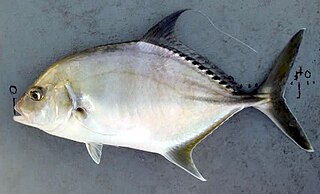
The coachwhip trevally, also known as the oblong trevally or oblique-banded trevally, is a species of inshore marine fish classified in the jack family Carangidae. The coachwhip trevally is distributed through the Indo-west Pacific region, ranging from South Africa in the west to Fiji and Japan in the east. It is a moderately large fish, growing to a known maximum length of 46 cm and can be distinguished from similar species by an array of detailed morphological features including dentition, fin ray counts and scale patterns. The coachwhip trevally inhabits coastal waters throughout its range, known to prefer estuarine waters in a number of localities. Nothing is known of its diet or reproductive biology, and is of little importance to fisheries, occasionally taken as bycatch in trawl and hook and line fisheries.

The barcheek trevally, also known as the barcheek kingfish, shortridge trevally or oblique-banded trevally, is a species of moderately large marine fish of the jack family Carangidae. The barcheek trevally is distributed throughout the tropical waters of the Indo-west Pacific region, ranging from South Africa in the west to Japan, Australia and a number of small central Pacific islands in the east. The species inhabits inshore and offshore waters, found along the slopes of lagoons and out to deeper reefs on the continental shelf, where it preys on small fish and benthic crustaceans. It is a moderately large fish, growing to a maximum recorded length of 50 cm, and can be distinguished from similar species by its somewhat protruding lower jaw and the dark banding on its operculum. It is of minor importance to fisheries throughout its range, taken by trawling, hook and line methods and various inshore fish netting methods.
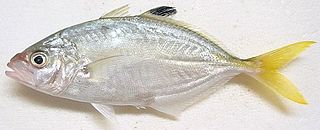
The brownback trevally, also known as the brown-backed trevally, is a species of small inshore marine fish classified in the jack family, Carangidae. The brownback trevally is distributed in two populations through the tropical waters of the Indo-west Pacific region, ranging from the Persian Gulf east to India, South East Asia and the Indonesian islands. The species is distinguished from similar species by its completely scaled breast and black-tipped second dorsal fin, and is known to reach a maximum length of 25 cm. The brownback trevally inhabits inshore waters including bays and estuaries, where it preys on demersal crustaceans and small fish. Other aspects of its biology are poorly known, and it is of minor importance to fisheries, occasionally caught by hook and line or trawls. William Smith-Vaniz has recently suggested the two distinct populations may actually represent two distinct species.

The imposter trevally, also known as the imposter jack or white-tongued trevally, is a species of small coastal marine fish in the jack family Carangidae. The imposter trevally is distributed through the tropical waters of Indian and west Pacific oceans, from the Gulf of Oman in the west to Japan and Australia in the east. The species is quite similar to the Malabar trevally, but can be distinguished by its gill raker count, and is identifiable from other species by having a white to pale grey tongue. It is a relatively small species, growing to a maximum recorded length of 30 cm. The imposter trevally inhabits coastal waters of the continental shelf in depths of up to 140 m, often associating with closely related carangid species. It preys on a range of small fish, crustaceans and cephalopods, but little is known of its reproductive biology. The imposter trevally is of minor importance to fisheries throughout its range, taken by hook and line, bottom trawls and several types of artisanal gear.

The longfin crevalle jack is a recently described species of large marine fish classified in the jack family, Carangidae. It inhabits the subtropical waters of the east Atlantic Ocean, ranging along the African coast from Mauritania south at least to Moçamedes in southern Angola, with the species historically present in the Mediterranean Sea. It is an inshore species, known to occasionally penetrate estuaries, possibly to spawn. The species is very similar to the crevalle jack, Caranx hippos, and is separated by its extended dorsal and anal fin lobes as well as more detailed anatomical features including dorsal and anal fin ray counts. The fish is known to reach 127 cm in length and 20.9 kg in weight. The longfin crevalle jack is a predatory fish, taking small fish as its main prey. Due to longstanding confusion between C. fischeri and C. hippos, the importance of each species to African fisheries is poorly understood, with a known combined catch in this region of between 2,233 and 10,054 tonnes per year in 1995–2004. Like its close relatives, the species is considered a powerful gamefish and highly sought after, although their coarse flesh makes for relatively poor quality food.

The cocinero, also known as the barred jack and striped jack, is a species of small marine fish classified in the jack family, Carangidae. The cocinero is distributed through the tropical eastern Pacific Ocean, ranging along the west American coastline from Baja California in the north to Peru in the south. It is a pelagic species, inhabiting the upper water column in both coastal and offshore oceanic waters, occasionally making its way into estuaries. The species may be identified by its colouration, having 8 or 9 incomplete dark vertical stripes on its sides, with scute and gill raker counts also diagnostic. It is small compared to most other species of Caranx, reaching a length of 37 cm in total. The cocinero is a predatory fish, taking small fishes, crustaceans, and various benthic invertebrates in shallower waters. Little is known of the species' reproductive habits. The cocinero is of moderate importance to fisheries along the west coast of South America, and the species has been used in aquaculture trials. It is taken by various netting methods and by spear, and is sold fresh, dried, and salted at market.





















